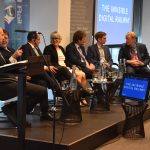The 2017 Digital Rail Summit examined the visible and invisible aspects of digitising the railway and took place at Bird & Bird’s offices in London on April 26.
The following is an excerpt of a full report from the summit, which will be available to read in next month’s edition of RailStaff (Click here to subscribe).
For some, the digital railway is narrowly defined as the modernisation of signalling and telecommunications, and this element was duly touched on by speakers from Siemens and Alstom. Progress to implement ERTMS is painfully slow; one of the reasons being suggested is the inability of the supply chain companies to fulfil their real potential by being constrained with over prescriptive specifications and innovation restriction.
The Internet of Things concept is not new but what is it exactly and how does it fit into rail? David Gate from EAMS gave a definition of a ‘thing’ – any object with embedded electronics and a network connection. Such ‘things’ can generate massive amounts of data and from this comes the term ‘Big Data’, 95 per cent of this collected information is reckoned not to be acted upon but if it were to be, reliability, response to incidents, prediction of failures and asset intelligence in many industries would be much improved.
Above: Pictures from the Digital Rail Summit. Click to see in full.
The big threat to all of this is cyber security. Some alarming statistics were disclosed by SNC Lavalin. Would anyone really want to hack into the railway? To find out, the Honeytrain project was set up with a real control system established on a simulated piece of railway, all set up to a manufacturer’s specification. In a six week period, 2.7 million hacking attempts were observed, a staggering figure.
Smart ticketing is one element of the digital railway and Dennis Rocks from the Rail Delivery Group offered interesting stats. He said that 600,000 smart tickets are already in use, 90,000 of these in London and added that Fenchurch St station had 1.2 million tap ins/outs in 2016. Paper mag stripe tickets are on the decline and likely to be phased out by 2023 but are the only option for some journeys at present.
Has the onset of the digital railway improved traveller experience? Work done by Nexus Alpha would suggest it has. Satisfaction levels measured in 2016 are better than those of 2006 (shown in brackets). Areas probed were: information at stations 82% (77%); staff availability and knowledge 66% (57%); train borne information 70% (63%); train staff helpfulness 44% (37%); dealing with delay 35% (34%). The latter two items, whilst improved, still have a long way to go.
Thanks to the Digital Rail Summit sponsors ADComms, Amey, Bird & Bird, Costain and Westermo.













